Related Research Articles
The Pennsylvania Railroad, legal name The Pennsylvania Railroad Company, also known as the "Pennsy", was an American Class I railroad that was established in 1846 and headquartered in Philadelphia. It was named for the commonwealth in which it was established. At its peak in 1882, the Pennsylvania Railroad was the largest railroad, the largest transportation enterprise, and the largest corporation in the world.

The American Locomotive Company was an American manufacturer that operated from 1901 to 1969, initially specializing in the production of locomotives but later diversifying and fabricating at various times diesel generators, automobiles, steel, tanks, munitions, oil-production equipment, as well as heat exchangers for nuclear power plants.

Baldwin Locomotive Works (BLW) was an American manufacturer of railway locomotives from 1825 to 1951. Originally located in Philadelphia, Pennsylvania, it moved to nearby Eddystone in the early 20th century. The company was for decades the world's largest producer of steam locomotives, but struggled to compete when demand switched to diesel locomotives. Baldwin produced the last of its 70,000-plus locomotives in 1951, before merging with the Lima-Hamilton Corporation on September 11, 1951, to form the Baldwin-Lima-Hamilton Corporation.
The Erie Railroad was a railroad that operated in the Northeastern United States, originally connecting Pavonia Terminal in Jersey City, New Jersey, with Lake Erie at Dunkirk, New York. The railroad expanded west to Chicago following its 1865 merger with the former Atlantic and Great Western Railroad, also known as the New York, Pennsylvania and Ohio Railroad.

The New York, Susquehanna and Western Railway, also sometimes referred to as New York, Susquehanna and Western Railroad, Susie-Q or the Susquehanna, is a Class II American freight railway operating over 400 miles (645 km) of track in three Northeastern states, New Jersey, New York, and Pennsylvania.
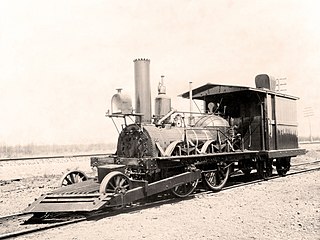
John Bull is a historic British-built railroad steam locomotive that operated in the United States. It was operated for the first time on September 15, 1831, and became the oldest operable steam locomotive in the world when the Smithsonian Institution ran it under its own steam in 1981. Built by Robert Stephenson and Company, it was initially purchased by and operated for the Camden and Amboy Railroad, the first railroad in New Jersey, which gave it the number 1 and its first name, "Stevens". The C&A used it heavily from 1833 until 1866, when it was removed from active service and placed in storage.

The Cooke Locomotive and Machine Works, located in Paterson, New Jersey, manufactured steam railroad locomotives from 1852 until it was merged with seven other manufacturers to form American Locomotive Company (ALCO) in 1901.

4-4-0, in the Whyte notation, denotes a steam locomotive with a wheel arrangement of four leading wheels on two axles, four powered and coupled driving wheels on two axles, and no trailing wheels.
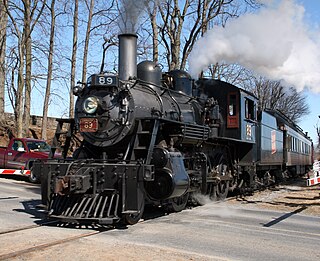
Under the Whyte notation for the classification of steam locomotives, 2-6-0 represents the wheel arrangement of two leading wheels on one axle, usually in a leading truck, six powered and coupled driving wheels on three axles and no trailing wheels. This arrangement is commonly called a Mogul.
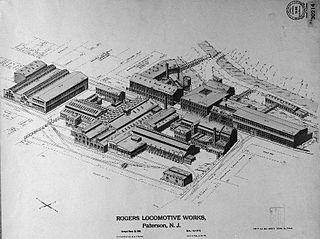
Rogers Locomotive and Machine Works was a manufacturer of railroad steam locomotives based in Paterson, in Passaic County, New Jersey, in the United States. Between its founding in 1832 and its acquisition in 1905, the company built more than 6,000 steam locomotives for railroads around the world. Most 19th-century U.S. railroads owned at least one Rogers-built locomotive. The company's most famous product was a locomotive named The General, built in December 1855, which was one of the principals of the Great Locomotive Chase of the American Civil War.

The Norris Locomotive Works was a steam locomotive manufacturing company based in Philadelphia, that produced nearly one thousand railroad engines between 1832 and 1866. It was the dominant American locomotive producer during most of that period and the first major exporter of American locomotives, selling its popular 4-2-0 engines to railways in Europe and building the first locomotive used in South America.

Dickson Manufacturing Company was an American manufacturer of boilers, blast furnaces and steam engines used in various industries but most known in railway steam locomotives. The company also designed and constructed steam powered mine cable hoists. It was founded in Scranton, Pennsylvania by Thomas Dickson in 1856. In total, the company produced 1,334 steam locomotives until it was taken over by ALCO in 1901.

The BLH RS-12 railroad locomotive was a 1,200 hp (895 kW) diesel-electric road switcher locomotive configured with an AAR type B-B wheel arrangement. It was the follow-on model to the former Baldwin DRS-4-4-1000, first introduced in 1948. It was more successful than its predecessor selling 50 units to eight railroads, versus 22 units to three railroads. Only one railroad, The Pennsylvania Railroad bought both models.
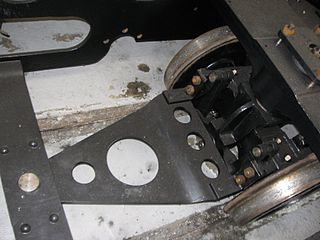
A Bissell or Bissel truck is a single-axle bogie which pivots towards the centre of a steam locomotive to enable it to negotiate curves more easily. Invented in 1857 by Levi Bissell and usually then known as a pony truck, it is a very simple and common means of designing a carrying wheel.
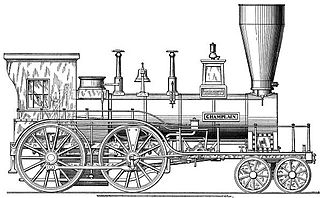
The Taunton Locomotive Manufacturing Company was one of the earliest firms in the United States established especially for the manufacture of steam locomotives. Located in Taunton, Massachusetts, the company was organized in 1849 and incorporated the following year by William A. Crocker, Willard W. Fairbanks, William R. Lee and their associates. Their first engine, the Rough and Ready was delivered in May 1849.

The Northern Pacific class S-10 was a type of steam locomotive in use on American railroads in the early 20th century. The first engines of the type were introduced in 1905, and ten were acquired by the Northern Pacific Railway (NP) in 1907, continuing in service until the 1930s and 1940s. One of the engines, Specifically No.328, has been preserved.

El Paso & Southwestern Railroad No. 1 is a 4-4-0 type steam locomotive, preserved in El Paso, Texas. The engine was built in 1857 by Breese, Kneeland, and Company of Jersey City, New Jersey, and is the only locomotive built by that firm still in existence.
The New York Locomotive Works, sometimes known as the Rome Locomotive Works, was a nineteenth century builder of steam locomotive engines located at Rome, New York. The company was active under various ownerships in building steam locomotives from 1882 until 1911. The New York Locomotive Works should not be confused with the earlier Breese, Kneeland, and Company which traded under the same name in the 1850s. The company was organized in 1881 with T. G Noch, a prominent local businessman as president. J. A. Durgan, a well known designer of steam locomotives was appointed superintendent, a position he had previously held at the Rhode Island Locomotive Works. The company was an instant success, as railroads were expanding a feverish pace. NYLW offered a robust, no frills locomotive and was well connected with banking interests that allowed sales along the "Car Trust Plan" with payments out to ten years.
References
- ↑ American Steam Locomotive Builders by John S White Jr., Bass 1982
- ↑ Crifasi, Beverly W. "Personal papers, articles, photographs and family history of the Gould Family". Historical Society of West Caldwell, NJ.
- ↑ American Steam Locomotive Builders by John S White Jr., Bass 1982
- ↑ The American Steam Locomotive by John S White Jr., Johns Hopkins Press 1968
- ↑ Engineer (Philadelphia) Nov 1, 1860, pg 93
- ↑ ref missing
- ↑ North American Steam Locomotive Builders by Harold Davies, TLC 2005
- ↑ American Steam Locomotive Builders